Forward stance is one of karate's bread-and-butter stances, and it's the first fighting stance that most students learn. It's a versatile stance, from which you can perform most strikes, blocks and kicks. It's an excellent stance from which to practice hip rotation. It forms the basis of the first kata.
Forward stance was one of the stances that was deliberately exaggerated by Gichin Funakoshi when he formulated the style that was to become Shotokan. Its longer length develops the thigh muscles, which are the key to explosive movement in half forward stance.
The stance provides strong resistance against attacks from the front, and its low height minimises the amount of frontal body area available for your opponent to strike. However, it's very weak against attacks from the forward diagonal (from the north-east if the left leg is forward), and the rear diagonal (the south-west if the left leg is forward).
It lacks the fast mobility of more upright stances, and is an impractical stance from which to initiate movement. Thus, it's more likely to be a finishing position, perhaps after a lunge or a large backward step.
Technique:
| # | Description |
|---|---|
| 1. | It's one shoulder width broad and two shoulders widths long. The front leg is bent at the knee at least 45 degrees, and the front shin should be vertical, with the knee above the ankle. The back leg should be straight, but the knee should not be locked at the joint (which will cause joint damage over a period of time) - instead, you should use your muscles to hold the leg a fraction short of straight. The rear foot faces forwards at an angle of at least 45 degrees (measured on the outside edge of the foot). The front foot is turned slightly inwards and the front knee is pushed outwards slightly over the shin. |
| 2. | Your centre of gravity should be forwards with approximately two-thirds (66%) of your weight on the front leg, and the remainder on the back leg. Your body should also be two thirds of the way to the front. |
| 3. | Your hip rotation depends upon the action that you are performing, and with which limb you are performing it, so your hips may face forwards for a punch or kick, or to 45 degrees for a block. However, you also want to roll your hips forwards from the bottom upwards. |
| 4. | Although both feet should be flat on the floor, your pressure should be on the inside of the feet. Regardless of whether you are moving forwards or backwards, your pressure against the ground is forwards through your front foot and backwards through your rear foot. |
Technical:
There are many forces at work in this stance. The essence is to achieve maximum transferral of strength to your arm or body via the straight back leg. The leg transfers power to the hip. If you are attacking, you will want to use the straightening of the back leg, in conjunction with rotation of the hip and shoulder, to maximise the amount of energy being transferred along the arm. However, to accomplish this successfully, you will also want to synchronmise these movements with your body's forward momentum, and the timing of your foot hitting the ground.
For stability, you will not want a punch to land whilst your foot is in the air, but for maximum body weight, you will not want to strike after your foot has been planted as this dissipates some of your energy downwards. I suggest that you should make contact just as your toes land, and complete your strike as your heel lands.
By pushing the front knee out, you reduce your vulnerability to a round knee kick. Sports physios also say that this is the safest way to bend the knees if you wish to avoid joint damage caused by the strain. By bending the front knee, you increase your strength against front kicks to the knee (but you increase your vulnerability to sweeps). You also make it easier to create tension between the legs to increase the strength of the stance. When you step forwards, it is the bend in the knee that forces you to pull yourself forwards with front leg, moving from the hips. Do not lean your shoulders forwards to initiate your movement! This is opposite to normal walking where steps are initiated by creating tension in the back thigh in order to step forwards under gravity. It is the pulling action caused by the lowness of the stance, that gives this stance its exercise benefits.
When you step backwards, you lead with the shoulders, as you balance on the supporting leg, you should experience a sensation similar to sitting down on a chair. As you do so, you extend your leg backwards under control.
The angle of the back foot is critical. If you were to turn it fully out to the side (90 degrees to the front), it would lock your back knee (because the knee bends poorly to the side). This would make the stance strong but immobile. However, if you have your toes facing fully forwards, the stance lacks strength, but becomes very dynamic, enabling fast movement. With the foot facing forwards, the heel has to raise from the ground, creating tension in the calf muscle. This creates a store of potential energy that is only released when you step forwards. By setting the foot to 45 degrees, you select a compromise, which offers the best of both worlds.
Given the fact that the stance is more likely to be used at the end of single commited movement, the ability to be very dynamic is perhaps less vital.
In its natural position, you'll have a tendency to allow the hip to turn off, dropping backwards on whichever side has the back leg. This can be useful for throwing a front arm block, or for cocking a reverse punch strike.
If your stance is too narrow, you'll find it virtually impossible to square the stance off for a fully effective reverse punch. However, if you go too wide you lose the hip angle for the blocks. The angle is also useful because it minimises your body's exposure to attacks. People with lower back problems will probably want to set their stance a little wider to reduce the strain.
When moving in forward stance, it's generally a good idea to keep your feet as close to the ground as possible without sliding them. Apart from anything else, this way of moving forces you to tense your stomach to maintain composure. Thus, at your moment of greatest potential vulnerability, your stomach is already prepared to take a strike. Even if this were not the case, this type of movement helps to build up your stomach muscles. This way of moving slightly reduces your exposure to sweeps, and more importantly means that if you need to shorten your stance halfway through a step, you still remain in balance. The only danger with this type of movement is if you find yourself fighting in trainers, or on an uneven surface - then you can find your feet sticking or getting caught on obstacles.
Your toes should be gripping the floor in order to create tension and strength in the stance. However, don't grip so hard that that your toes bend downwards, as this endangers you to foot stamps, which would then be far more damaging.
Common mistakes to avoid:
- Don't allow the back knee to bend.
- Make sure the front knee is pushed out the side.
- Don't set the stance too wide when stepping forwards.
- Don't set the stance too narrow or short, especially when turning.
- Push the stance down from the hips, and don't allow yourself to stand tall as you get tired.
- Ensure that the hips are facing the correct direction for the technique you're performing.
- Don't allow the back foot to turn out too far.
- Don't scrunch your toes up as you grip the floor.
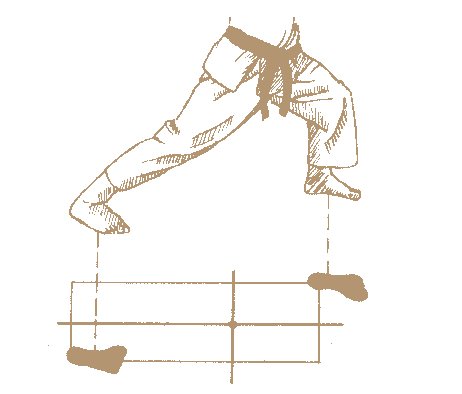
Zenkutsu-dachi (Front stance).
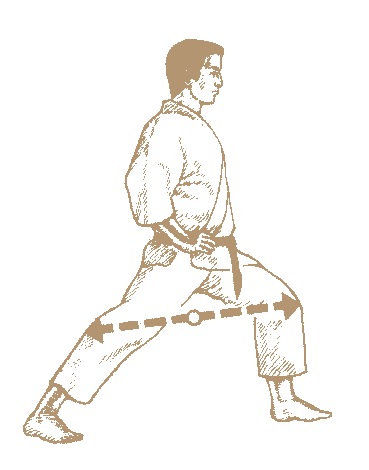
Knees strongly obtuse along the extension of the line.
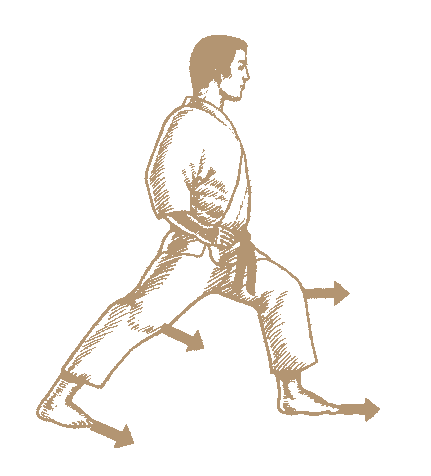
The knees and toes of each foot must point in the same direction.
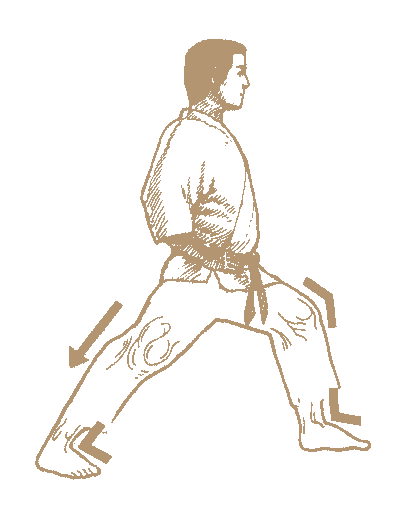
Knee and ankle joints must be sufficiently bent and strongly locked.
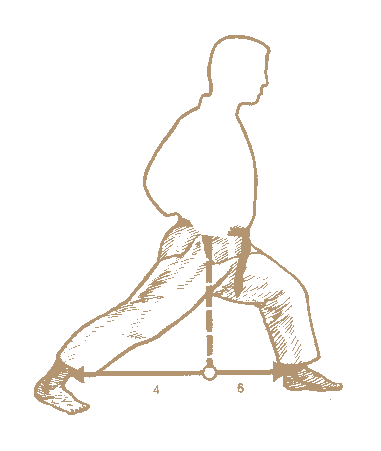
Weight distribution in leg posture should be 40% to 60%. This weight distribution can also very.
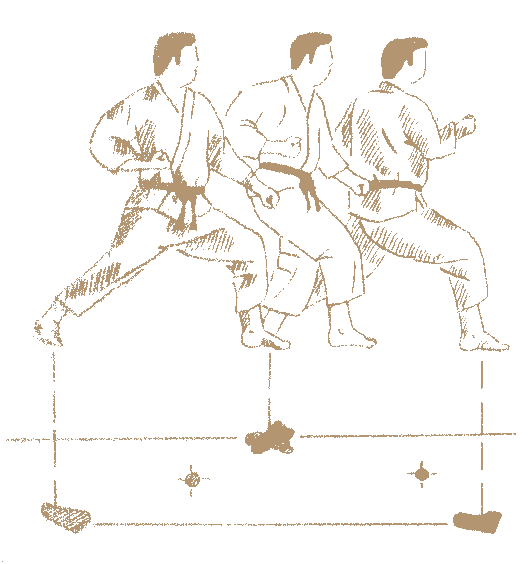
Moving in zenkutsu-dachi
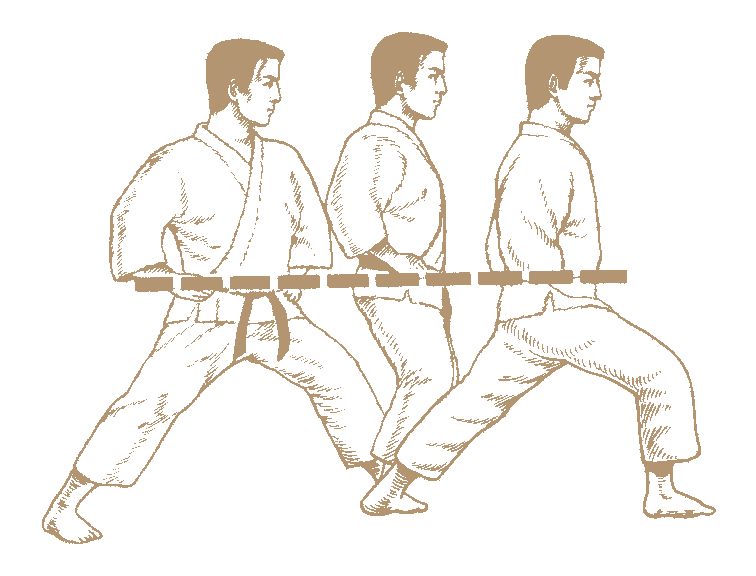
Movement in the zenkutsu-dachi attitude Movement - the right form.
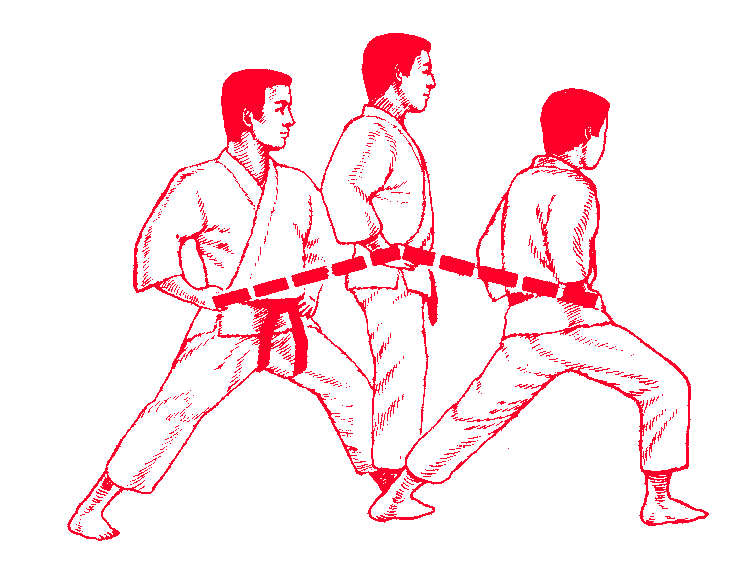
Movement in a zenkutsu-dachi attitude - wrong form.
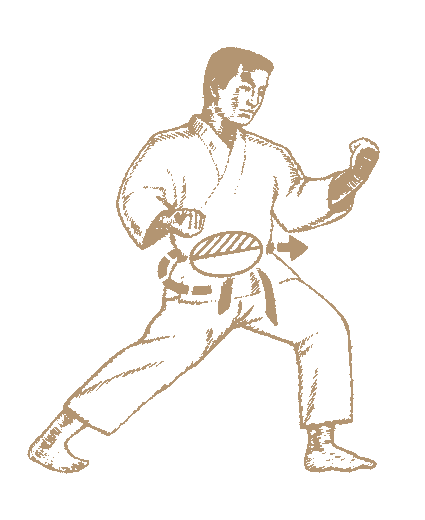
Semi-frontal position (Hanmi) in zenkutsu-dachi.
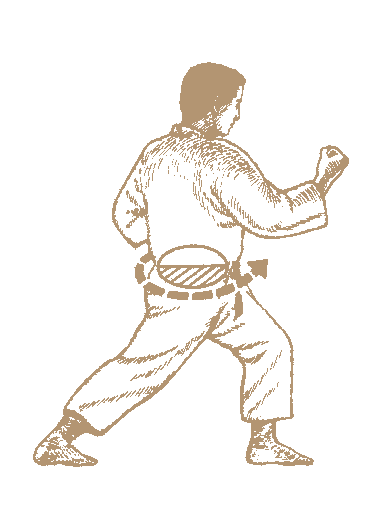
The reverse opposite position (Gyaku-hanmi) in zenkutsu-dachi.
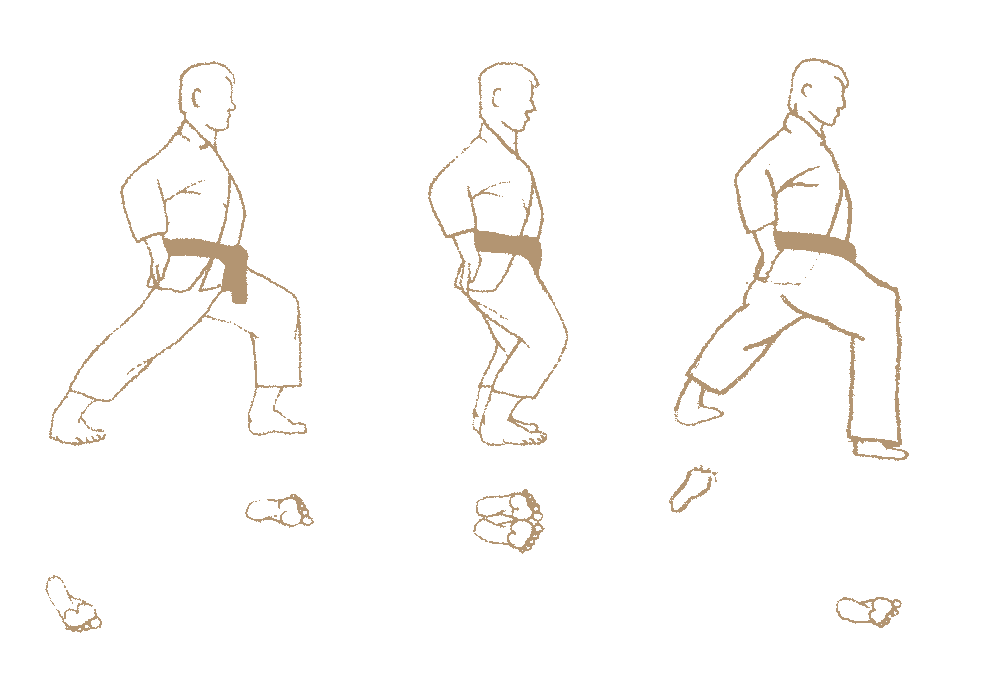
In the exercise, we should try not to touch the right foot on the surface and maintain the same height level.
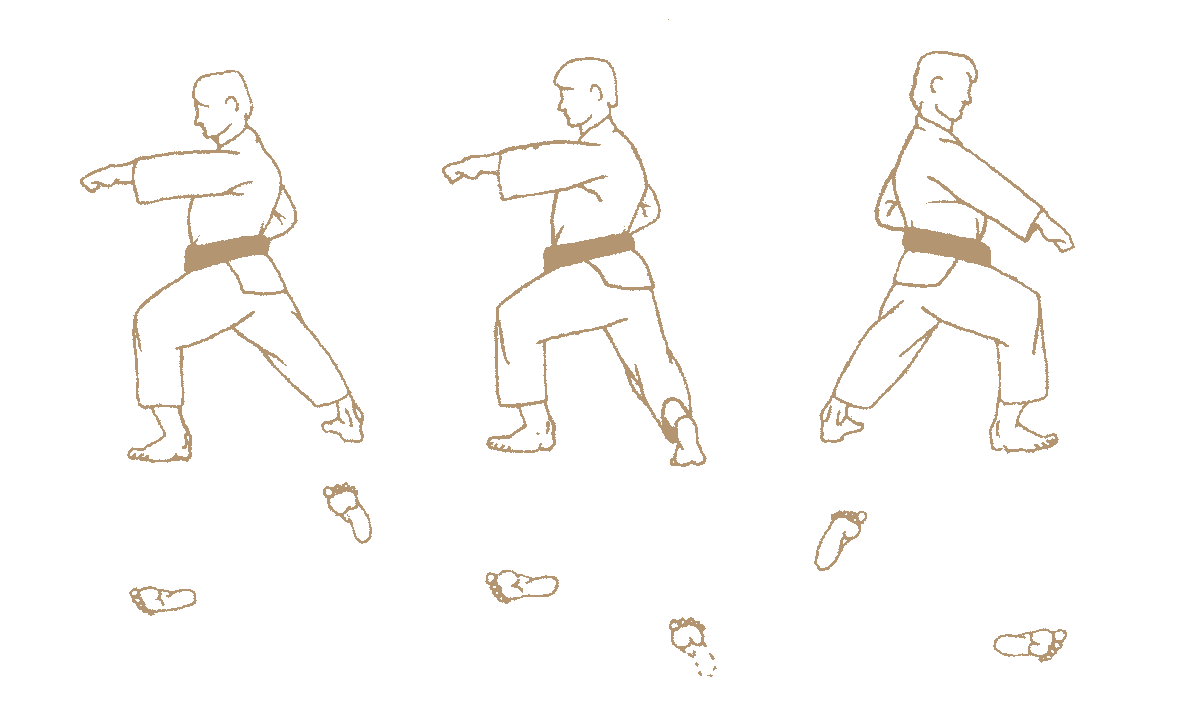
Return on 180 degrees with zenkutsu-dachi position (with the left leg) to the zen-kutsu-dachi posture (with the right leg)
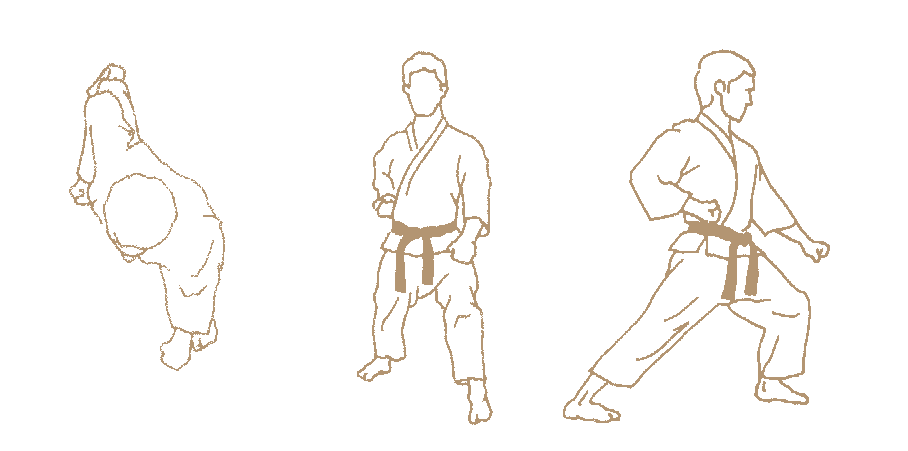
Different views of the zenkutsu-dachi posture.
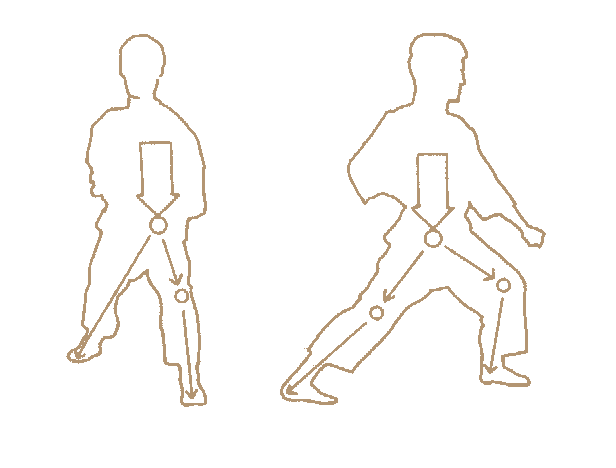
Distribute the gravity forces in the zenkutsu-dachi posture.

Putting feet in zenkutsu-dachi in the exercise on stumps.






